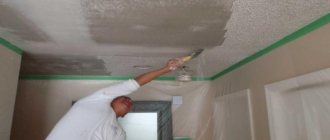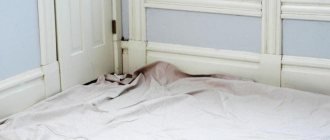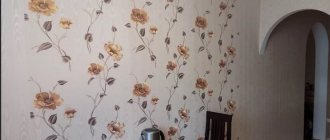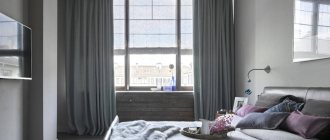Blinds are a universal means of protection from the sun's rays in the early morning or on bright summer evenings. Sometimes there is simply no opportunity to purchase curtains, and making them yourself requires a lot of effort.
This is where blinds will help you out. You can buy them in a store at a lower price or make them yourself using a roll of wallpaper and other scrap materials. Our detailed photo and video instructions, which describe the entire process step by step, will also come to your aid.
Handmade products have always been famous for their quality and originality. Manual labor is valued much higher than refined innovative technologies. Without much effort, you can make your own blinds in your favorite colors, adding variety to the room. Such curtains look creative and will not go unnoticed by your guests.
Wallpaper blinds have certain advantages over alternative options:
- availability, low price. All you need is paper wallpaper, strings, tapes and tools available in every home;
- fire safety;
- ease of manufacture;
- the ability to combine with other curtains, blinds. You choose the required color yourself, decorate in accordance with the interior;
- adjustable length and width. In any window opening, blinds will look appropriate and presentable;
- simplicity and versatility in fastening and installation.
Among the shortcomings are noted:
- Difficulty in cleaning curtains from dust and dirt. They are easily damaged and should not be wetted with water;
- they quickly lose their original appearance and are short-lived;
- If the window opening is too wide, it becomes difficult to adjust the size.
What tools are needed?
In order to make curtains from wallpaper with your own hands, you need to prepare the following materials for work:
- Paper fabric with a selected design or pattern;
- Cardboard;
- Wax candles. It is worth removing the wick from them in advance;
- Pot;
- Brush;
- Scissors or hole punch;
- Strong threads or twine.
If one or more materials are not available, you can replace them with improvised means. For example, use paraffin candles instead of wax candles.
How are paper curtains made?
In order to be able to make your own curtain from thick paper, you first need to attach two beams to the window opening underneath it. The width of these elements must correspond to this indicator of the prepared canvas. Next, the curtain needs to be secured with glue or small nails to the block that is located on top. If an adhesive composition is chosen as the fastening element, then you need to hold the curtain a little so that it can be fixed. So, next you need to do the following:
- We make holes on the curtain using an awl. This is necessary in order to then pass a thick thread or a special cord;
- Next we fasten this thread to the top bar. We tie a knot and glue this place to make it secure;
- Now we do exactly the same actions for the curtain from below. This is necessary so that the structure can be lowered or raised at the required moment.
After all this is done, we need to wait for our product to dry. Now we can say that the curtain, made with your own hands, is ready.
Let's get down to business
Wallpaper curtains are made in several stages. Here is their description:
- First, you need to lay out cardboard on the table that matches the width and length of the future curtains.
- Next, you should heat a wax or paraffin candle in a saucepan and quickly apply the liquid consistency onto the cardboard.
- Place a sheet of wallpaper on the cardboard until the wax hardens.
- Heat the remaining paraffin again and brush the wallpaper on top with a brush.
- Take a second sheet of wallpaper and place it on top of the first layer of paraffin.
- To achieve maximum bonding of the paper on all layers, iron the paper. This will allow the paraffin to saturate the paper and distribute evenly between it.
- On the other side, where the cardboard is visible, it is necessary to carry out the same actions. Thus, in general, the curtains will consist of four layers of wallpaper paper and one inner cardboard layer.
- Take a hole punch or scissors. Make holes in future curtains for twine or thread.
Ropes can serve both as an attachment to a curtain or any other base, and as a way to lift the curtain upward.
Where and how to attach?
There are many types of fastening:
- On a window sash that rotates. This can be done with glue, double-sided tape, and if wooden frames are used, then with push pins.
- On the window frame - so that the blinds cover the entire window.
- On the wall near the window, on top of the entire opening.
- For a frame for curtains - for those cases when a heavy structure with a sliding mechanism is made of paper.
Other types of fastening are possible. Here everything depends on the imagination of the manufacturer.
How to make curtains using these tools?
- Fold the paper sheet like an accordion, having previously made marks with a pencil in the places where the folds will be. Use a ruler to avoid distortions.
- The curtains need fasteners, so glue the top folds together.
- Make holes in the paper for fishing line or cord, onto which the curtain will be gathered.
- You need to put a cord stop at the bottom of the curtain. It will prevent the assembled canvas from falling down. The limiter can be an ordinary button larger than the hole in the paper.
This option for making curtains is much simpler and takes less time than the first. Self-made curtains can be attached to the curtain rod with hooks.
What it is?
Attention
Blinds are a type of curtain consisting of individual elements. The purpose of this accessory is to cover the windows from excess light and indiscreet views from the outside.
They can be made from different materials - thin wooden slats, fabric strips on the frame, plastic elements, etc. One of the best options is paper blinds. Their advantages:
- Low price . Paper is cheaper than thin wood without defects.
- Lightness . Such a curtain can be hung on any window with virtually no additional fasteners.
- Environmental friendliness . Unlike plastic or varnished wood, paper does not emit phenol, phthalate, or any other foreign substances.
- The ability to make them yourself with minimal skills . At the same time, using different types of paper you can achieve any decorative effect.
The main disadvantage is its fragility: the paper cannot be washed, and under the sun it quickly turns yellow and fades. Typically, paper blinds last no more than a year, then they need to be replaced. But this drawback is not so significant as to refuse such a convenient accessory.
Types of paper curtains
Currently, several variations of wallpaper curtains have been invented. Among them are blinds, Roman blinds, roller blinds and panels.
Paper blinds
Wallpaper blinds are the most common case of decorating the interior of residential apartments, offices and coffee shops. Here are step-by-step instructions for creating blinds.
- Measure the window glass on which the paper curtains will be placed and add 25% to the length of the window. This calculation will allow you to find out how much wallpaper will be needed for finished blinds.
- Take a lace or ribbon along the length of the curtain with an allowance for knots or bows.
- The cut part of the wallpaper needs to be folded like an accordion. In this case, the gap from fold to fold should not exceed 3-5 cm, since wider stripes will not look aesthetically pleasing.
- Also, as in previous cases, you need to make holes using a hole punch or an awl and insert the laces into them. To increase the service life of the blinds, you need to cover with tape on the back side the places where the thread or fishing line will pass to support the curtains.
- You will need to glue double-sided tape to the top step of the blinds, which is attached to the window. It will hold not only the paper web, but also the strings threaded into it.
- If desired, you can also glue double-sided tape to the bottom strip to decorate the edge. A lace ribbon or braid is used to frame the bottom.
- To open and close the blinds, you will need a single-opening latch. As a decoration, you can hang a large bead on the end of the cord.
Any housewife can make such curtains. The main thing is to have a few free hours left.
Roman curtains
Roman blinds are almost identical in design and manufacture to blinds. However, stylistically there are differences. The bottom of Roman curtains made from wallpaper is decorated with a semicircular accordion. This design is called a peacock tail. However, this condition is not necessary for fabric curtains.
The width of the lower folds does not exceed 3-4 cm. It is worth noting that the rope for assembling the curtain is not passed along the sides, as is the case with blinds, but in the center of the canvas.
Paintable wallpaper is perfect for Roman blinds. Their paper is thin and allows light into the room well. This design will look good in the interior of a hallway, kitchen or dining room.
Roller blinds
Roller curtains also have much in common in their design with Roman shades and blinds. However, their distinctive feature lies in the rope mechanism, thanks to which, when lifted, the canvas is wound around the bar.
To make roller curtains you will need two wallpaper sheets of the same size, 2 laces, slats, a furniture stapler, a wooden cornice and ribbons for garters. Making roller blinds is a little more complicated than in previous cases.
First you need to sew or glue the wallpaper so that you get a bag. Next, the wallpaper is turned out and the joints are folded. The sinker is placed in the cut, which is then taped or sutured. The upper part of the curtain and garter is fixed to the wooden cornice using a stapler.
Curtain panels
This type of curtain will require wooden frames. Typically, bars with a cross-section of 3x3 cm are taken. Metal corners and screws are used to connect them. The frame dimensions are determined independently depending on the window parameters.
Wallpaper paper is cut into strips, which are attached to the frames at intervals of 3-4 cm. Self-tapping screws are screwed into the panel at the top. Here you should pay attention to the fact that they do not need to be completed by about 5 cm. Next, a cornice with drilled holes is attached to the ceiling at equidistant distances corresponding to the spaces between the screws. Thus, the screws hold the entire structure on the window.
Types of paper curtains
Cut-out curtains have a unique design and mechanism. You can choose the style, make them in your own style with the addition of details. Below are popular varieties.
Vertical blinds
Strips of curtains, called slats, are arranged vertically. They rotate at the desired angle and are adjusted with a special rope.
Horizontal blinds
The curtains are characterized by a ladder mechanism. The slats are arranged crosswise. They are raised and lowered by a special drum.
Roller blinds
Blinds that are rolled up using a special mechanism.
Roman curtains made of paper (peacock tail)
Blinds similar to horizontal ones, with a distinctive feature - a rounded fan bottom.
Curtain installation options
One of the important points is the installation of curtains. There are several methods for attaching curtains to a window:
- inside the opening. On the top of the window frame, opening, or on the wall above the window itself. To do this, mark the horizon, use fastening materials that are convenient for you;
- outside the opening. Suitable for non-standard windows located shallow in the wall. It will help to darken the room better. Installation may involve special brackets or mounting to the ceiling;
- to the window frame. This method of fastening is especially suitable for plastic windows. Curtains can be attached to the sashes using special fasteners. Opening and closing windows will be much more convenient.
Simple cornice
Before you start making pendants, you first need to make a cornice. For the cornice, use a regular wooden plank or tube. You can take an old window curtain rod or use a new one.
It is important to remember that the length of the cornice must be greater than the width of the opening. Thus, the curtain completely covers this place, while slightly extending onto the walls.
The cornice is installed on nails or special fastenings (brackets). You can use any means to make curtains. Each option will add beauty to the interior and is very simple: beads, shells, coins, newspapers, fragments of CDs and much more.
From fabric
To make such curtains, you need to cut out a piece of fabric in the form of a rectangle. Its size should exactly match the size of the window opening in your home. Allowances for seams, top fastening and pocket at the bottom must be taken into account.
- Each of the side edges should be processed using an overlocker or machine. At the bottom you need to sew a pocket into which the weight bar will fit. As for this part itself, a part of an aluminum profile or a wooden strip, which exactly matches the width of the window, is perfect for it.
- How you handle the top of the curtain depends on how you plan to mount the blinds. The product can be fixed on the wall surface, mounted on a cornice that was previously purchased in a store, or hung on a block of wood. You need to measure the required piece to which you will attach future curtains. As for the rest of the canvas, it needs to be carefully marked with a simple pencil for future folds.
- The most optimal width of each fold will be considered to be a size that is in the range from 10 to 20 cm. At the same time, leaving a distance between the marking lines, you must ensure that there are no unmultiple residues at the top. Along each of the intended lines, they adjust the braid and thread thin slats made of plastic into the resulting pockets. They will serve to support the shape of the folds.
- After this, lines are drawn along which the vertical laces will go. For each of these markings, rings are sewn onto the braid. If you have a standard size window, then it is quite possible to get by with three cords. The number of rings you need should be equal to three times the number of folds.
- Next, you should thread the laces into the resulting product and secure it with knots at the bottom of the curtain. Make hooks on the cornice and hang the top curtain rings there. This will be the final stage. After this, you need to pull the laces through all these rings that are at the top.
To secure them to the wall surface, nail a hook. That's it, now you can enjoy the finished product!
DIY options
Homemade blinds can be made in a variety of ways, each producing a slightly different result.
Classic way
Work is performed on a free, flat surface. This is necessary in order to avoid distortions while unwinding the rolls and performing the necessary actions.
Video: Master class on making blinds from wallpaper with your own hands
Making blinds from wallpaper looks like this:
The result is a rather original interior element, on which a minimum of time and money is spent.
More complicated way
There is another option where it will take more time, but the result will be more attractive.
Step-by-step making of blinds from wallpaper with your own hands:
- Preliminary marking of the window frame is carried out.
- Strips 10 cm wide are cut. All parts must be smooth, without distortions.
- The fragments made in this way are folded in half and glued along the cut edges. That is, you should get a flattened tube.
- Next is the most difficult moment: each part has a center line at the top and bottom. Thus, the strip is divided into two parts.
- Glue is applied to this line, and the next fragment is glued on top. Each part is glued in the center to the other, you should get an “accordion” with holes.
- After connecting all the elements, the product is left until completely dry.
- Stepping back 100–150 mm from the edge, holes are punched and cords are passed through, which are secured at the bottom with a clamp and at the top with tape.
- To strengthen the structure, you can use a thin wooden strip, to which the upper edge of the wallpaper is glued, and a rope is passed through the holes made and rings are tied.
The operating principle of the curtain is the same as in the previous version.
Cork
Cork curtains
This product looks quite nice, and it doesn’t require much investment.
To make such a curtain, you should collect wine corks (from bottles) in advance.
In addition to them, you will need a plank made of wood, which will serve as the base of such unique curtains.
Don't forget fishing line and a large needle.
You can replace them with a nylon rope and a thin nail.
At the next stage of making curtains for your window, you will need to cut the base from a wooden plank exactly to the same dimensions as the opening.
Next you need to tie a nylon thread or fishing line of the exact length with which you will make each part of the curtain and attach the plugs.
Even a child can handle the manufacturing technology. You just need to thread the thread or fishing line with a needle through the plugs.
To prevent such parts from moving in different directions in the future, they should be secured with small knots under each of them. They must be larger than the diameter of the hole.
Features of Roman blinds
Why are Roman blinds so popular? Now they are easy to find in premises for various purposes: from residential buildings to offices or even doctor’s offices. It turns out that the whole point is a very simple design and convenient use.
Roman blinds have a rich history: they were first used, of course, during the Roman Empire. With their help, it was easy to create an optimal level of lighting and comfort in the home. Actually, since then such curtains began to be called Roman.
Roman blind in a modern interior
It is interesting that throughout its existence, Roman blinds have not changed structurally. This is a cornice that is fixed to the window frame or ceiling, as well as a solid canvas that has special inserts that will help control the curtain. It can be raised and lowered. using special laces. Neat and beautiful folds are formed on the assembled fabric. In modern realities, such curtains are most often created from curtain fabrics, but other materials can also be used.
Roman blinds help provide soft diffused light in the room and provide a private and pleasant atmosphere. They are quite appropriate in the kitchen, office, bedroom, and living room. They are convenient and easy to use, and caring for them is a piece of cake.
Accessories for roller blinds
Correctly selected fittings will make the curtain easy to use and create an attractive appearance. As accessories you can choose:
- Cornice. Will act as interior decoration. Such accessories are expensive, suitable for a living room or bedroom. If you have small windows and want to visually expand the space, then choose curtain rods 30-40 cm wider than the window. You can also hang the curtain rod just above the window opening.
- Runners, hooks. Economical, simple option for the kitchen. You will not have any problems with choosing sliders - they are all the same in terms of the method of fastening. All you have to do is decide on the appearance.
- Brackets, chains. The chain mechanism is very easy to use and is popular. Brackets are a durable structure onto which the shaft is mounted. If the blinds are made of thick wallpaper, then it is better to choose long brackets.
- Ropes. The rope mechanism is inexpensive and easy to implement: to do this, sew rings to the side panels and pass threads through them. Attach them to the bottom of the curtain.
- Weights. Serves as a weighting agent. Such a decorative accessory will allow you to emphasize the entire roll structure. All models have different colors, shapes, sizes, and styles, so you can choose the appropriate option for your blinds.
- Additional accessories: handles, decorative strips, other parts.
Types of mechanisms
There are two types of fastening roller blinds: open and closed:
- When the type is open, the cassette shaft on which the web is wound is visible. The shaft is mounted between two holders. This type of mechanism will allow you to fix the curtains above the window opening and in the opening itself. Wallpaper curtains can be controlled using a spring mechanism or a chain. Double-sided tape can serve as a fixation. The disadvantage of this design is that the adhesive layer can melt during the heat. Therefore, it is better to use self-tapping screws or self-tapping screws. The open type of fastening is a budget option that is available to anyone.
- The closed type differs from the first by the presence of a box that masks the cassette shaft, protects it from dust and dirt, and gives the structure a neat appearance. This system is suitable for plastic, wooden and aluminum windows. The system can only be mounted with an inclination of 15°. The closed type of mechanism is more difficult to implement and more expensive than the open type. Installation is carried out by drilling the frame. The control method can be using a chain, a spring mechanism or an electric drive. The latter allows you to adjust the level of illumination remotely using the remote control.
Set of components
In order to install paper curtains with your own hands, you will need the following components:
- plastic or metal box, its guiding element;
- plugs for the box;
- chain, if a manual mechanism is provided;
- connecting elements for the chain;
- brackets;
- a clamp that will fix roller curtains at any distance;
- adhesive tape (double-sided tape), holders, supports for attaching the shaft to the ceiling;
- bracket-clamp, if a spring mechanism is provided.
Step-by-step master classes
To create high-quality, neat blinds, follow the instructions step by step, take your time, and be especially careful in your measurements.
The advantage of homemade curtains is the lack of work with drawings.
Each variety has manufacturing features and requires an individual approach. Therefore, decide in advance what kind of curtains you would like to see on the windows.
Accordion blinds
To make blinds from wallpaper with slats bent like an accordion:
- Measure the window in length and width. Add a quarter of the material from the length of the window to the length of your curtains. Otherwise, when folded like an accordion, the curtains will be a quarter shorter.
- Carefully measure the length of the rope according to the length of the curtain.
- Give the piece a pleated look. To do this, measure the strips (it is better if they are from 3 to 5 cm, then the blinds will look elegant and neat.). Make sure that the slats are the same shape. Bend them into an accordion shape.
- If you want to thread the rope along the fabric, use an awl to make a row of holes in the middle of the curtain and insert the lace. You can insert two laces by making holes on the sides.
- Attach the top end of the cord by tying a knot or using tape. If you used two cords, connect them using a clamp, placing a bead at the end or tying a knot.
To make your blinds look three-dimensional, you can increase the width of the slats. This will make the blinds look massive and stylish.
Roller blind
For this option, you will need a tube to secure the curtains. It is best to make blinds from non-woven wallpaper. To make roller blinds, use step-by-step instructions:
- Attach double-sided tape along the entire length of the tube.
- Fix the inside of the curtain to the pipe. Screw the fabric onto the pipe until the very end. Try to roll the wallpaper very tightly.
- Bend the lower end of the fabric by about 5–10 mm, depending on the width of the weight. Insert a weight bar into the resulting groove. Use a weight exactly the width of the blind.
- Insert a mechanism into the pipe to adjust the blinds. Secure the mechanism with a rope or chain at the top of the window. Use double-sided tape or self-tapping screws for this. Or, as shown in the picture, secure the hooks to the top of the curtain by threading the cords through them.
You can learn more about this from the video:
DIY wallpaper blinds\We make roller blinds from wallpaper with our own hands
Fan blinds (peacock tail)
Fan blinds involve steps similar to making accordion blinds. The difference lies in the rounded end of the curtain, reminiscent of a peacock's tail. To make curtains, follow the instructions:
Learn more about this from the master class:
How to make blinds from wallpaper Master class from Angelina Bykova
Blinds made from newspaper tubes
A newspaper is a universal thing in everyday life. Another interesting use for it is making curtains.
To create curtains, follow these steps:
If you do not understand the technology of making curtains from newspaper tubes well, refer to the video MK:
Weaving from newspapers. Blinds. Master Class.
Curtains made from paper clips
To create curtains from paper clips, you can use different threads, leftover wallpaper, magazines, old postcards, and corrugated paper.
This type of curtain looks very original and catchy, due to the sparkling clips. The curtain is considered a good idea for the cottage and garden because of the ease and convenience with which it can be pulled back.
Its production is as follows:
A creative solution would be to secure the threads to some kind of wooden stick. You can use thread instead of paper. To keep the curtain beautiful and sparkling for a long time, you can coat it with glossy varnish.
The author's imagination in this manufacturing option is not limited.











